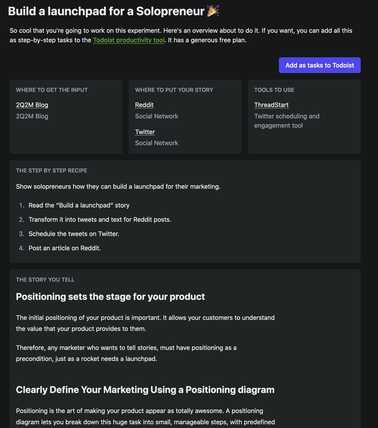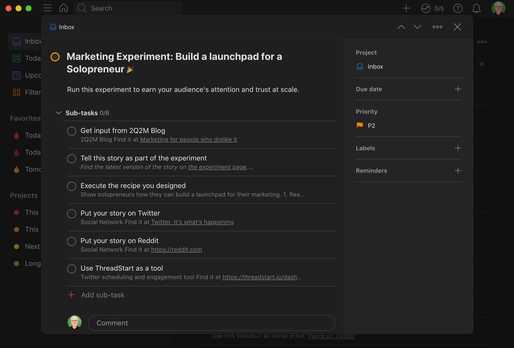Experiment
What is an Experiment?
A marketing experiment is a systematic procedure to test a new way to reach your audience and convince them to use what you have to offer.
You put something out there, have people consume it, and see what happens. Then you decide about the next steps.
It's a 6-step process:
- Make a hypothesis about what will happen when you market your stuff
- Choose a channel to reach your prospects (e.g. social network, blog, email)
- Tell a story (with text, images, audio, or video), via that channel
- Measure how people react to your story
- Learn by comparing reality to your hypothesis
- Keep what works, ditch what doesn't, then go to step 1.
Why it's difficult for solopreneurs to run marketing experiments
As a solopreneur, you wear many hats at the same time. You prefer building to marketing. But building or creating all day won't make people notice what you have to offer.
Some time ago, I acknowledged that it's true: I need marketing to sell the software that I build. From Jon Yongfook (maker of Bannerbear), I learned that there is a good rhythm for building and marketing:
- 1 week of coding
- 1 week of marketing
When you decide to adopt this rhythm, you may likely run into a problem. Whenever you return from building to marketing, you will probably have forgotten one or more of these things:
- What story did you want to tell this time?
- Where is the material (text, images, etc.) for that story?
- Which channel do you want to use (your blog, your email list, your Twitter)?
Holy smokes, I once even forgot how to write and publish a blog post or a newsletter, only because I was so deep into building my software! 😳
This will lead nowhere. We have to prepare and write everything down so that running an experiment becomes dead simple when marketing time comes around.
Preparation is key, you only need it rarely
You only need to prepare once. Then you can run a bunch of experiments. Then you prepare again, for the next batch. Preparation makes it much easier to run successful experiments.
This is how to prepare for your first experiment:
- Nail your positioning.
- Get totally clear on your messaging.
- Bookmark your channels, material, places and tools.
Execution is easy, once you're prepared
With the preparation above, you're good to go. Define your experiments, run them, and learn from them. This is how you do it:
Define the experiment
This interactive demo shows you how to turn a story into an experiment.
Click-thru demo: How to create an Experiment
Run the experiment
- Open your project and click on the "Experiments" tab.
- The list of your experiments will appear.
- Click on the "Tasks" link of the experiment you want to run.
The Tasks view will appear. It tells you exactly where to find the stuff you need, where to put the results, which tools to use, and the step-by-step recipe that you wrote down:

Integrate marketing into your to-do list in Todoist
2Quiet2Market integrates with Todoist, a popular task management app. For each experiment you design using the Experiment Designer, 2Quiet2Market generates a main task in Todoist, along with subtasks that are easy to understand and feel good to check off as completed.
Click on "Add as tasks in Todoist" to allow 2Quiet2Market to login and add some tasks.
Open Todoist, and you'll see a main task for the experiment, with several subtasks for the activities you wanted to do:

If you are unfamiliar with Todoist, it is a powerful tool that helps you organize and prioritize your tasks, so you can get more done in less time. With the integration of 2Quiet2Market, you can easily track your progress as you work through each marketing experiment, and feel a sense of accomplishment as you check off each task.
(Todoist has a generous free plan, so don't worry about money here.)
Execute one new experiment weekly
You may find it hard to come up with a new experiment every week or so.
Here's a formula that will help you: story * channel = experiments.
This means, if you got 4 stories to tell and 3 channels to use, you can run 4 times 3 = 12 experiments!
With one experiment per week, that's 12 weeks of experiments: Ample time to discover new stories or new channels, so you'll never run out with things you have to give to your prospects.
From each experiment, you will learn:
- What story performed well?
- Which channel gave a loud echo, and which ones were just pure silence?
Comments welcome: